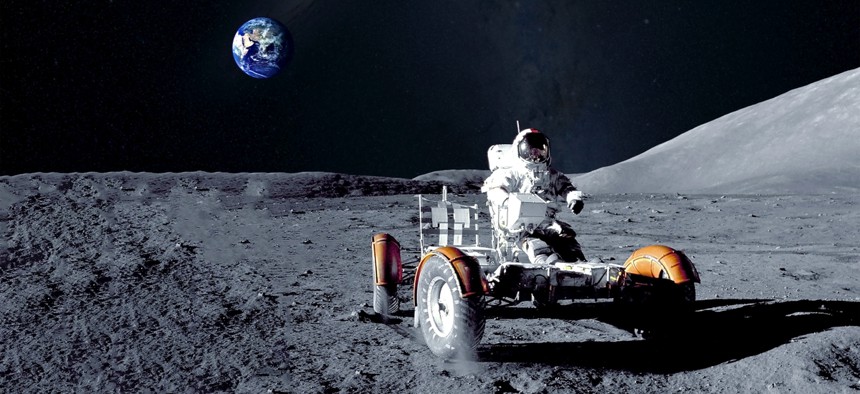NASA Solicits Ideas on its Future Moon Rovers

Artsiom Petrushenka/Shutterstock.com
It’s all part of what the agency calls “a coordinated approach to explore the lunar surface.”
NASA plans to land the first woman and next man on the moon by 2024 and then eventually send astronauts to Mars in the 2030s—all through its ambitious Artemis program. As the space agency prepares for the journeys, it wants Americans to weigh in on the future of lunar rovers and the next wave of maneuverability around the moon’s surface.
NASA issued two separate requests for information and an announcement this week, garnering how it should approach the “development of robotic mobility systems and human-class lunar rovers” to advance on-the-moon exploration.
“With these RFIs, NASA seeks to foster an emerging American market of lunar transportation capability by engaging the terrestrial vehicle and robotic communities,” officials said.
In the Lunar Surface Science Mobility System, or LSSMS-1 RFI, NASA solicits information on sustainable, uncrewed robotic systems that can transport scientific samples and instruments as well as exploration tools and materials across the moon’s surface—and also conduct unprecedented research around its terrain. The agency intends for the systems to be equipped with capabilities that will allow them to venture and probe into areas of the moon “where humans may not explore.” Regarding LSSMS-1, Deputy Associate Administrator for Exploration in NASA’s Science Mission Directorate Steve Clarke said the agency wants approaches to how it may “leverage existing systems here on Earth—including law enforcement, military, or recreational vehicles—that could be modified for use in space to enhance our mobility architecture.” Responses to this RFI are due March 6.
The agency also aims to broaden the reach of its astronauts as they explore the moon. Through its Lunar Terrain Vehicle, or LTV RFI, NASA wants industry to weigh in on technologies and acquisition strategies it should embrace to develop and access cutting-edge rovers that will help the moon’s visitors conduct investigations around its surface—and even venture where humans have yet to go: the lunar South Pole. Marshall Smith, director of human lunar exploration programs in NASA’s Human Exploration and Operations Mission Directorate, said the LTV RFI is not exclusive to the space industry, but instead, NASA wants insight from industry players across all-terrain vehicles, electric vehicles, and more. “We want our rovers on the moon to draw on, and spur, innovations in electric vehicle energy storage and management, autonomous driving, and extreme environment resistance,” Smith said. Responses to the LVT RFI are due Feb. 26.
Together, the two solicitations make up what the agency called a “coordinated approach to explore the lunar surface, to perform new science investigations, and to use the missions to test out systems for further exploration and scientific investigation of the solar system.” NASA also plans to host a virtual industry forum on Feb. 12 to expand on its ultimate strategy and address questions from potential responders.






